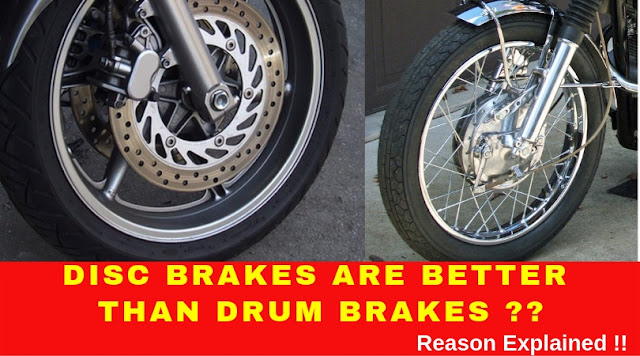Brakes are the most important safety feature of any automobile. There are two kinds of brakes which are generally used in case of passenger vehicle: disc brakes and drum brakes.
With the advent of new technology, motorcycles are getting more powerful and faster. Gone are the days when people used to buy a bike to just commute from point A to B. Now, customers look for performance when buying a motorcycle. With the increase in power and speed, the brakes also needed an upgrade.So disc brakes are an update to drum brakes.In this article we will discuss how disc brakes are better than drum brakes.
2.)Stopping Power: The disc brake offers efficient stopping power compared to drum brake. We can also increase the bite of the brakes by adding bigger pads or multiple pads. Having dual disc is also an option to increase the braking power.
3.)No Wheel Damage: In a drum brake system, shoes are connected to a spring which causes friction with the wheel. So, the friction might result in overheating inside the wheel and it could damage the wheel gradually. But there is no such problem with the disc brakes.
4.)Maintenance: During the maintenance of a disc brake, you only need to clean the disc and the pads with a sanding paper. But during a periodic maintenance of a drum brake, you need to remove the entire wheel.
5.) Affordable Spares: Both the disc and the brake pads are not that expensive and it can be changed very caliper. But if something goes wrong with the drum brakes, there are chances of damage to the wheel. So a damaged wheel could be an expensive affair.
Let us first discuss how disc brakes works:
When you pull the brake lever, the oil is pushed towards the calipers and in turn; it applies pressure on the pads which creates friction with the disc to slow or stop the motorcycle.This is demonstrated in animation below:
How disc brakes are better than drum brakes:
1.)Heat Dissipation: As the disc brake is located outside the wheel, it cools down easily as compared to drum brake. The drum brake is located inside the wheel, so chances of brakes getting heated are very high.2.)Stopping Power: The disc brake offers efficient stopping power compared to drum brake. We can also increase the bite of the brakes by adding bigger pads or multiple pads. Having dual disc is also an option to increase the braking power.
3.)No Wheel Damage: In a drum brake system, shoes are connected to a spring which causes friction with the wheel. So, the friction might result in overheating inside the wheel and it could damage the wheel gradually. But there is no such problem with the disc brakes.
4.)Maintenance: During the maintenance of a disc brake, you only need to clean the disc and the pads with a sanding paper. But during a periodic maintenance of a drum brake, you need to remove the entire wheel.
5.) Affordable Spares: Both the disc and the brake pads are not that expensive and it can be changed very caliper. But if something goes wrong with the drum brakes, there are chances of damage to the wheel. So a damaged wheel could be an expensive affair.
Although there are few disadvantages with disc brakes like wheel lockup,high initial cost and brake fluid maintenance but these disadvantages of disc brakes are negligible. Disc brakes are always better than drum brakes and can deliver excellent braking performance.
Most companies usually offer disc brakes at just the front-end on some of their smaller displacement offerings. This helps improves braking while also keeping the price of the motorcycle in check.




































